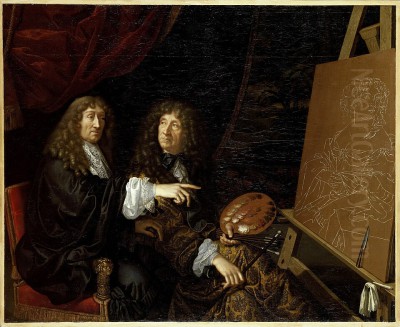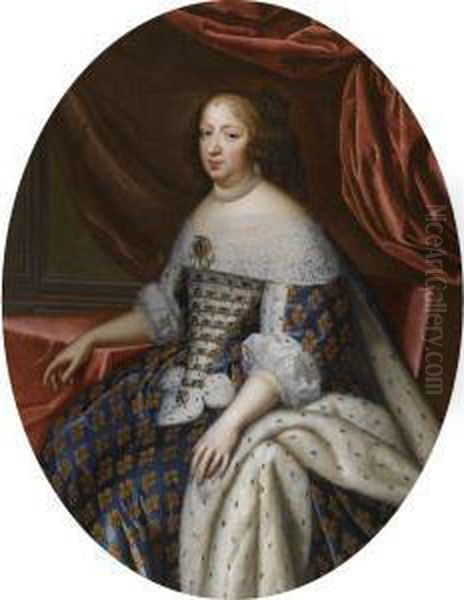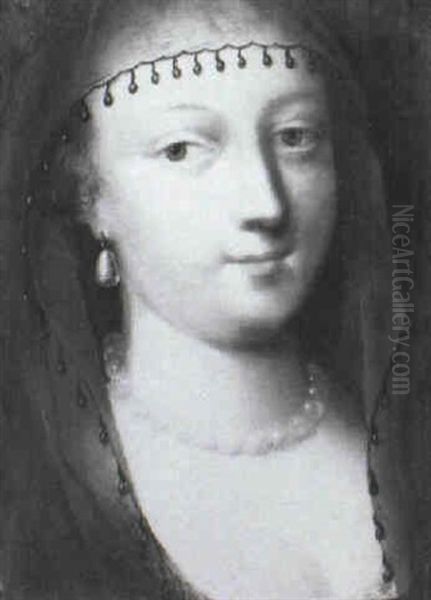Introduction: A Painter in the Age of Splendor

Charles Beaubrun (1604–1692) stands as a significant figure in the rich tapestry of 17th-century French art. As a prominent court portrait painter, he worked during the reigns of Louis XIII and, most notably, Louis XIV, the Sun King. His career is inextricably linked with that of his cousin, Henri Beaubrun (1603–1677), with whom he formed one of the most enduring artistic partnerships of the era. Together, they captured the likenesses of French royalty and aristocracy, creating images that reflected the power, elegance, and evolving artistic tastes of the French Baroque period. Their work provides invaluable visual documentation of the key personalities who shaped one of the most dazzling epochs in French history.
Early Life and Artistic Formation in Amboise
Born in Amboise, a town steeped in royal history, Charles Beaubrun hailed from a family already established in the artistic profession. This familial connection provided a crucial pathway into the world of painting. His primary training came under the tutelage of his uncle, Louis Beaubrun (died 1627), himself a respected painter who enjoyed the patronage of King Louis XIII. This apprenticeship not only honed Charles's technical skills but also offered him early exposure to the demands and expectations of courtly art. Growing up in this environment, alongside his slightly older cousin Henri, laid the foundation for their future collaboration and shared artistic journey.
The Unison of Cousins: The Beaubrun Collaboration
The professional relationship between Charles and Henri Beaubrun is a remarkable aspect of their careers. Their collaboration was so close and stylistically unified that art historians often find it challenging, if not impossible, to definitively distinguish the individual hand of each cousin in the works attributed to them jointly. This partnership likely began early in their careers and continued for decades until Henri's death in 1677. They operated essentially as a single artistic entity, particularly renowned for their portraiture. This collaborative approach allowed them to manage a significant output of commissions, maintaining a consistent quality and style that became their hallmark at the French court.

Their shared studio produced numerous portraits that were simply signed "Beaubrun," signifying their joint effort. This practice underscores the depth of their artistic synergy. While Charles outlived Henri by fifteen years, continuing to paint, the bulk of their most famous works belongs to the period of their active partnership. Their combined talents resulted in a distinctive style that blended meticulous detail with courtly grace.
Service to the Crown: Painting Royalty
The Beaubruns rose to prominence under King Louis XIII, but their influence solidified during the regency of Anne of Austria and the subsequent personal rule of Louis XIV. They became favoured painters for official portraits, tasked with capturing the images of the royal family for posterity and political dissemination. Their sitters included the most powerful figures of the time: Anne of Austria herself, often depicted with pious dignity; a young Louis XIV, portrayed both as Dauphin and as the emerging monarch; and the King's brother, Philippe, Duke of Anjou, later Duke of Orléans.
These royal portraits served multiple functions. They were dynastic records, symbols of legitimacy and continuity, and tools of statecraft, projecting an image of majesty, order, and divine right. The Beaubruns excelled in rendering the opulent fabrics, intricate lace, and gleaming jewels that signified the sitters' status, while also striving to capture a recognizable likeness imbued with appropriate gravitas. Their depictions of the royal children, in particular, offer a fascinating glimpse into the early lives of figures destined to dominate the European stage.
Founding Members of the Académie Royale
The establishment of the Académie Royale de Peinture et de Sculpture (Royal Academy of Painting and Sculpture) in 1648 was a pivotal moment in French art history. It aimed to elevate the status of artists, centralize artistic training and doctrine under royal authority, and break the monopoly of the old guild systems. Charles and Henri Beaubrun were among the founding members (membres fondateurs) of this prestigious institution. Their inclusion signifies their established reputation and their alignment with the centralizing cultural policies promoted by the Crown, particularly under the influence of Cardinal Mazarin and later Jean-Baptiste Colbert.

Within the Académie, Charles Beaubrun later held administrative roles, serving as a treasurer and teacher. This involvement demonstrates his commitment not only to the practice of painting but also to the institutional framework shaping French art. Membership in the Académie provided artists with enhanced status, access to royal commissions, and a platform for theoretical discussion, further cementing the Beaubruns' position within the artistic elite. Their participation placed them alongside other influential founders and early members like Charles Le Brun and Philippe de Champaigne.
Artistic Style: Blending Baroque Grandeur and Classical Elegance
The style of Charles Beaubrun, largely inseparable from that of Henri, reflects the complex artistic currents of 17th-century France, navigating between the dramatic impulses of the Baroque and the ordered restraint of Classicism. Their work is primarily characterized by its application to portraiture, where conveying status and likeness was paramount.
Baroque elements are evident in the richness of textures, the deep, often jewel-toned colours, and the careful attention to the play of light on luxurious fabrics like silk, satin, and velvet. While their compositions are often formal and balanced, adhering to courtly decorum, they sometimes incorporate gentle movement or a more direct psychological engagement with the viewer. The meticulous rendering of details, especially in costume and jewellery, contributes to a sense of tangible presence and opulence, hallmarks of Baroque sensibilities aimed at impressing the viewer.
Simultaneously, their work retains a strong element of Classical clarity and order. Figures are typically presented with a calm dignity, avoiding excessive emotional display. The brushwork is smooth and refined, aiming for an idealized finish rather than visible, energetic strokes. There is an emphasis on elegance, poise, and a certain harmonious balance in the composition. This blend resulted in portraits that were both sumptuously detailed and formally restrained, perfectly suited to the tastes of the French court, which valued both magnificence and decorum. They mastered the art of portraying individuals not just as persons, but as occupants of specific, elevated ranks within a strict social hierarchy.
Capturing Likeness and Status: The Portrait Specialist
The Beaubruns specialized in portraiture, mastering the conventions of the genre as practiced in the highest circles. Their approach focused on creating a recognizable likeness while simultaneously idealizing the sitter according to contemporary notions of beauty and nobility. They paid extraordinary attention to the details of costume, which served as crucial indicators of wealth, status, and fashion. Pearls, lace collars, embroidered silks, and elaborate hairstyles are rendered with painstaking precision.

Their use of light is generally clear and even, illuminating the sitter to reveal features and costume details without resorting to the dramatic chiaroscuro seen in works by artists like Caravaggio or Rembrandt. The backgrounds are often simple, perhaps a dark neutral tone or a draped curtain, ensuring that the focus remains entirely on the subject. Common formats included the bust-length, three-quarter-length, and occasionally full-length portraits, particularly for the most important royal figures. The overall impression is one of elegant formality, meticulous craftsmanship, and a quiet, dignified presence.
Representative Works: Icons of the French Court
While distinguishing Charles's precise contribution from Henri's is difficult, several key works are attributed to their collaborative efforts and represent their significant output:
Portraits of Anne of Austria: The Beaubruns painted Louis XIV's mother, the Regent Anne of Austria, on numerous occasions. These portraits often depict her in mourning attire (after the death of Louis XIII) or emphasizing her piety, reflecting her public image. The detail in her lace, pearls, and sombre fabrics is characteristic of their style. These works convey her authority and resilience during the turbulent period of the Fronde.
Portraits of the Young Louis XIV and his Brother Philippe: They produced several charming portraits of the royal children. A notable example depicts the young Louis XIV and his brother Philippe, Duke of Anjou (later Duke of Orléans), often dressed in similar finery, sometimes holding symbols of their status. These works capture a sense of youthful innocence combined with the weight of their royal destiny. The Portrait of Philippe, Duke of Anjou, dated around 1642, shows the young prince with careful attention to his features and rich clothing.
State Portraits of Louis XIV: As Louis XIV matured, the Beaubruns contributed to the evolving iconography of the Sun King. While later artists like Hyacinthe Rigaud would create the most famous, overtly powerful images of the monarch in his absolute prime, the Beaubruns captured him in earlier stages, documenting his transition from boy-king to young ruler. Their Portrait of Louis XIV around the 1650s showcases their skill in rendering royal regalia and conveying a sense of burgeoning authority within a formal framework.
Portraits of Court Ladies: Beyond the immediate royal family, the Beaubruns painted numerous portraits of aristocratic women at court. These works are valuable records of period fashion and ideals of female beauty. The anecdote mentioned in the source material about a portrait featuring a lady in blue adorned with abundant jewels, used to symbolize female power or independence, highlights how their detailed rendering of adornment could carry symbolic weight, reflecting contemporary social attitudes and the sitters' self-perception.
Context and Contemporaries: Beaubrun in the Artistic Landscape
To fully appreciate Charles Beaubrun's contribution, it's essential to place him within the vibrant artistic milieu of 17th-century France and Europe. He worked during a period of intense artistic activity, shaped by the competing influences of Italian Baroque, Flemish realism, and a burgeoning French classical tradition.
In France, his contemporaries included major figures who shaped the era's artistic identity. Philippe de Champaigne (1602–1674) was a direct rival in the field of portraiture, known for his austere, psychologically penetrating portraits influenced by Jansenism, offering a stylistic contrast to the Beaubruns' courtly elegance. The dominant figure was Charles Le Brun (1619–1690), premier peintre du roi (First Painter to the King) and director of the Gobelins Manufactory and the Académie. While primarily a history painter, Le Brun's influence permeated all aspects of official art. Other notable French contemporaries included classicizing painters like Laurent de La Hyre (1606–1656) and Eustache Le Sueur (1616–1655), both co-founders of the Académie, and landscape painters like Claude Lorrain (1600–1682) and Nicolas Poussin (1594–1665), whose classically inspired works, though often created in Rome, profoundly influenced French art theory and practice. The Le Nain brothers (Antoine, Louis, and Mathieu) offered a different perspective with their realistic depictions of peasant life.
Looking beyond France, the influence of Flemish masters was significant. Peter Paul Rubens (1577–1640) had executed the Marie de' Medici cycle in Paris decades earlier, leaving a powerful Baroque imprint. The work of Anthony van Dyck (1599–1641), particularly his elegant court portraits painted in England, set an international standard that resonated across Europe, including France. In Spain, Diego Velázquez (1599–1660) was revolutionizing court portraiture with his masterful technique and psychological depth. The Beaubruns operated within this complex web of national trends and international influences, carving out their niche as specialists in refined French court portraiture. They preceded the next generation of great French portraitists, Hyacinthe Rigaud (1659–1743) and Nicolas de Largillière (1656–1746), who would develop a grander, more overtly Baroque style in the later reign of Louis XIV.
Legacy and Influence: Documenting an Era
Charles Beaubrun, together with Henri, left a significant legacy primarily as visual chroniclers of the French court during a formative period. Their extensive output provides an invaluable record of the key figures of the reigns of Louis XIII and the early-to-mid reign of Louis XIV. Their consistent style, characterized by meticulous detail, elegant composition, and refined technique, came to define a particular mode of French court portraiture – one that balanced formality with a degree of naturalism.
While perhaps not as innovative or influential in the grand sweep of art history as Poussin, Le Brun, or later Rigaud, the Beaubruns fulfilled a crucial role within the court structure. They upheld high standards of craftsmanship and provided the monarchy and aristocracy with the dignified images they required. Their collaborative working method remains an interesting historical case study.
Their influence can be seen in the continuation of a certain standard for formal portraiture in France. Artists who followed them built upon the foundations they helped establish, adapting the style to evolving tastes. Today, works by Charles and Henri Beaubrun are held in major museum collections worldwide, including the Louvre Museum and the Palace of Versailles in France, the Prado Museum in Madrid, the Victoria and Albert Museum, and the British Museum in London, ensuring their contribution to art history remains accessible. Regarding his precise dates, while 1604–1692 is commonly cited, some sources, including one provided in the initial prompt, mention a death year of 1694; 1692 remains the more generally accepted date.
Conclusion: Masters of Courtly Representation
Charles Beaubrun, inseparable in reputation from his cousin Henri, was a master of 17th-century French court portraiture. Born into an artistic family and trained under his uncle, he navigated the complex world of royal patronage with skill, securing a lasting position through diligent work and a refined, elegant style. As founding members of the Académie Royale, they participated in the institutional shaping of French art. Their numerous portraits of Louis XIV, Anne of Austria, Philippe d'Orléans, and other members of the aristocracy serve as vital historical documents and exemplars of the French taste for blending Baroque richness with Classical restraint. Though working in close collaboration, Charles Beaubrun's long career ensures his individual recognition as a key painter who meticulously captured the faces and fashions of France's Grand Siècle.